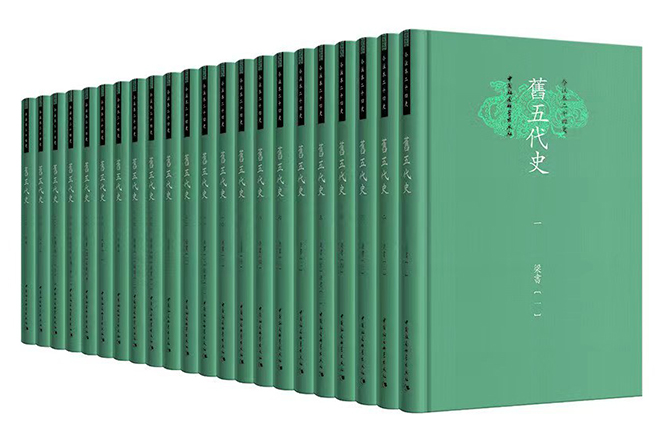Classics as foundation for modern Chinese civilization

FILE PHOTO: Old History of the Five Dynasties, one of the 24 volumes of Contemporary Variorum on Twenty-Four Histories
General Secretary of the CPC Central Committee Xi Jinping pointed out at a meeting on cultural inheritance and development on June 2 that “If one does not learn about China from the continuity of its long history, there is no way for him or her to understand ancient China, modern China, or China in the future.”
Status of official history
Twenty-Four Histories contains 24 historiographies, covering different time periods of the country’s history, from Shiji (Records of the Grand Historian) to Mingshi (History of Ming Dynasty). Currently, China’s system of such writings stands unparalleled in its continuity and comprehensiveness among nations worldwide.
In China, only the 24 histories can be called “official history.” The purpose of generalizing the history of various dynasties as “official history” is to form a political, historical, and cultural identity. Confirming dynastic orthodoxy is the foundation of establishing successive dynasties. In the fourth year (1739) of Qing Emperor Qianlong’s reign, the emperor authorized the Twenty-Four Histories as official history, and stipulated that those without imperial verdict shall not be included. Since then, official history has become its special name.
There were multiple reasons for the Qing court to grant the 24 records the status of official history. First, the confirmation of official history was to establish the historical ruling system of 24 dynasties, and was a basic step towards building traditional political and cultural order. It represents the standard temporal axis of the evolution of Chinese history. Second, China has the tradition of “writing the history of the previous dynasty by the following dynasty,” and the compilation took on the responsibility of affirming dynastic orthodoxy. Third, the official status of 24 histories responds to the inevitable requirement of the system of writing history in ancient China. During the Tang Dynasty (618–907), the rulers established a dedicated office responsible for recording historical accounts. This office, overseen by the prime minister, was tasked with compiling the history of the preceding dynasty. Over time, this practice evolved into a systematic obligation, serving the purpose of consolidating the historical lessons of past dynastic successes and failures. Additionally, it aimed to establish the legitimacy and orthodoxy of the current ruling dynasty.
Fourth, these official histories hold a significant position within Chinese historical literature. They can be regarded as a comprehensive account of ancient Chinese history, a definitive dynastic history, as well as a detailed and specialized history. The colorful figures described in these books, the lessons conveyed by the successes and failures of each dynasty, the general approaches to national governance, and the brilliant historical culture presented are unparalleled by any other classics.
Cultural inheritance
After nearly 30 years, the project of Contemporary Variorum on Twenty-Four Histories is close to completion. This unique format integrates historical texts with research outcomes since ancient times, embodying a modernized rendition of these historical accounts.
The collection is a large-scale and profound project, and is praised as the “Three Gorges project of Chinese culture” by academic circles. Comprising approximately 140 million characters across 24 volumes, this cultural endeavor represents a comprehensive and systematic compilation of China’s official history. To date, 18 of these volumes have been published. This ambitious project has brought together over 300 historians from various research institutions and universities across the nation, pooling their collective expertise and efforts.
The revision of historical facts is evident in this scheme. For instance, the chapter on Emperor Wen in Hanshu (History of Han Dynasty) records that Emperor Wen of Han (206 BCE–220) had issued an imperial decree stipulating that for a month the elderly over 80 years old can get one dan of rice, 20 jin of meat and five dou of wine; the elderly over 90 years old were entitled to receive an additional two bolts of silk and three jin of cotton. A dan in Han was equal to about 60 kilograms today, a jin equal to about 250 grams, and a dou equal to about 500 grams. As such, an annotation is provided suggesting that it was impossible to implement such high welfare measures in Han two millennia ago, the character “month” is probably a writing error, and that the provisions bestowed by Emperor Wen were likely a one-time measure.
The project makes remarkable efforts concerning the collection of historical data, serving as a foundation for the practice of “historians annotating history.” This involves the extensive collection of documents from reliable sources and the supplementation of annotated texts by way of annotations. In terms of annotating the criminal law section in Hanshu, scholars meticulously sift through classics, historical texts, and leishu [reference books with materials taken from various sources and arranged by categories], to uncover lost legal materials and add to annotations. There are numerous such additions in the published works.
Textual interpretation within the project incorporates the use of images to verify historical features, showcasing a unique approach to “historians annotating history.” Creating images with cultural relics or using images as historical materials can justify or falsify texts. The form of images can be employed to describe certain complex content which is difficult to express in language. The chapter on celestial phenomena in Shiji is annotated with a host of unearthed celestial images. The two chapters on carriages and costumes in Houhanshu (History of Later Han Dynasty) is also annotated with a great many images based on archaeological portraits, statues, and objects, generating a concerted illustrative effect together with written documents.
Sun Xiao is a research fellow from the Institute of History at the Chinese Academy of Social Sciences.
Edited by YANG LANLAN
